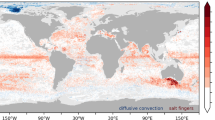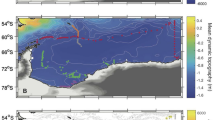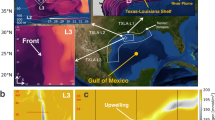Abstract
Diapycnal mixing (across density surfaces) is an important process in the global ocean overturning circulation1,2,3. Mixing in the interior of most of the ocean, however, is thought to have a magnitude just one-tenth of that required to close the global circulation by the downward mixing of less dense waters4. Some of this deficit is made up by intense near-bottom mixing occurring in restricted ‘hot-spots’ associated with rough ocean-floor topography5,6, but it is not clear whether the waters at mid-depth, 1,000 to 3,000 metres, are returned to the surface by cross-density mixing or by along-density flows7. Here we show that diapycnal mixing of mid-depth (∼1,500 metres) waters undergoes a sustained 20-fold increase as the Antarctic Circumpolar Current flows through the Drake Passage, between the southern tip of South America and Antarctica. Our results are based on an open-ocean tracer release of trifluoromethyl sulphur pentafluoride. We ascribe the increased mixing to turbulence generated by the deep-reaching Antarctic Circumpolar Current as it flows over rough bottom topography in the Drake Passage. Scaled to the entire circumpolar current, the mixing we observe is compatible with there being a southern component to the global overturning in which about 20 sverdrups (1 Sv = 106 m3 s−1) upwell in the Southern Ocean, with cross-density mixing contributing a significant fraction (20 to 30 per cent) of this total, and the remainder upwelling along constant-density surfaces. The great majority of the diapycnal flux is the result of interaction with restricted regions of rough ocean-floor topography.
This is a preview of subscription content, access via your institution
Access options
Subscribe to this journal
Receive 51 print issues and online access
$199.00 per year
only $3.90 per issue
Buy this article
- Purchase on Springer Link
- Instant access to full article PDF
Prices may be subject to local taxes which are calculated during checkout


Similar content being viewed by others
References
Munk, W. & Wunsch, C. Abyssal recipes II: energetics of tidal and wind mixing. Deep-Sea Res. I 45, 1977–2010 (1998)
Munk, W. H. Abyssal recipes. Deep-Sea Res. 13, 707–730 (1966)
Lumpkin, R. & Speer, K. Global ocean meridional overturning. J. Phys. Oceanogr. 37, 2550–2562 (2007)
Ledwell, J. R., Watson, A. J. & Law, C. S. Evidence for slow mixing across the pycnocline from an open-ocean tracer-release experiment. Nature 364, 701–703 (1993)
Ledwell, J. R. et al. Evidence for enhanced mixing over rough topography in the abyssal ocean. Nature 403, 179–182 (2000)
Polzin, K. L., Toole, J. M., Ledwell, J. R. & Schmitt, R. W. Spatial variability of turbulent mixing in the abyssal ocean. Science 276, 93–96 (1997)
Toggweiler, J. R. & Samuels, B. On the ocean’s large scale circulation near the limit of no vertical mixing. J. Phys. Oceanogr. 28, 1832–1852 (1998)
Garabato, A. C. N. et al. Widespread intense turbulent mixing in the Southern Ocean. Science 303, 210–213 (2004)
Kunze, E. et al. Global abyssal mixing inferred from lowered ADCP shear and CTD strain profiles. J. Phys. Oceanogr. 36, 1553–1576 (2006)
Sloyan, B. M. Spatial variability of mixing in the Southern Ocean. Geophys. Res. Lett. 32, L18603 (2005)
Wu, L., Jing, Z., Riser, S. & Visbeck, M. Seasonal and spatial variations of Southern Ocean diapycnal mixing from Argo profiling floats. Nature Geosci. 4, 363–366 (2011)
Gregg, M. C. Scaling turbulent dissipation in the thermocline. J. Geophys. Res. 94, 9686–9698 (1989)
Polzin, K. L., Toole, J. M. & Schmitt, R. W. Finescale parameterizations of turbulent dissipation. J. Phys. Oceanogr. 25, 306–328 (1995)
Nikurashin, M. & Ferrari, R. Radiation and dissipation of internal waves generated by geostrophic motions impinging on small-scale topography: application to the Southern Ocean. J. Phys. Oceanogr. 40, 2025–2042 (2010)
Nikurashin, M. & Ferrari, R. Radiation and dissipation of internal waves generated by geostrophic motions impinging on small-scale topography: theory. J. Phys. Oceanogr. 40, 1055–1074 (2010)
St Laurent, L. et al. Turbulence and diapycnal mixing in Drake Passage. J. Phys. Oceanogr. 42, 2143–2152 (2012)
Waterman, S., Naveira Garabato, A. C. & Polzin, K. L. Internal waves and turbulence in the Antarctic Circumpolar Current. J. Phys. Oceanogr. 43, 259–282 (2013)
Marshall, J. & Speer, K. Closure of the meridional overturning circulation through Southern Ocean upwelling. Nature Geosci. 5, 171–180 (2012)
Ledwell, J. R., St Laurent, L. C., Girton, J. B. & Toole, J. M. Diapycnal mixing in the Antarctic Circumpolar Current. J. Phys. Oceanogr. 41, 241–246 (2011)
Ho, D. T., Ledwell, J. R. & Smethie, W. M. Use of SF5CF3 for ocean tracer release experiments. Geophys. Res. Lett. 35, L04602 (2008)
Bevington, P. R. & Robinson, D. K. Data Reduction and Error Analysis in the Physical Sciences (McGraw-Hill, 1992)
Nikurashin, M. & Ferrari, R. Global energy conversion rate from geostrophic flows into internal lee waves in the deep ocean. Geophys. Res. Lett. 38, L08610 (2011)
Orsi, A. H., Whitworth, T. & Nowlin, W. D. On the meridional extent and fronts of the Antarctic Circumpolar Current. Deep-Sea Res. I 42, 641–673 (1995)
Zika, J. D., Sloyan, B. M. & McDougall, T. J. Diagnosing the Southern Ocean overturning from tracer fields. J. Phys. Oceanogr. 39, 2926–2940 (2009)
Webb, D. J. & Suginohara, N. Oceanography—vertical mixing in the ocean. Nature 409, 37 (2001)
Ledwell, J. R., Watson, A. J. & Law, C. S. Mixing of a tracer in the pycnocline. J. Geophys. Res. C 103, 21499–21529 (1998)
Wanninkhof, R., Ledwell, J. R. & Watson, A. J. Analysis of sulfur hexafluoride in seawater. J. Geophys. Res. C 96, 8733–8740 (1991)
Smethie, W. M., Schlosser, P., Bonisch, G. & Hopkins, T. S. Renewal and circulation of intermediate waters in the Canadian Basin observed on the SCICEX 96 cruise. J. Geophys. Res. C 105, 1105–1121 (2000)
Law, C. S., Watson, A. J. & Liddicoat, M. I. Automated vacuum analysis of sulfur-hexafluoride in seawater—derivation of the atmospheric trend (1970-1993) and potential as a transient tracer. Mar. Chem. 48, 57–69 (1994)
Busenberg, E. & Plummer, L. N. Dating groundwater with trifluoromethyl sulfurpentafluoride (SF5CF3), sulfur hexafluoride (SF6), CF3Cl (CFC-13), and CF2Cl2 (CFC-12). Wat. Resour. Res. 44, W02431 (2008)
McClean, J. L. et al. A prototype two-decade fully-coupled fine-resolution CCSM simulation. Ocean Model. 39, 10–30 (2011)
Meijers, A. J. S., Bindoff, N. L. & Rintoul, S. R. Estimating the four-dimensional structure of the Southern Ocean using satellite altimetry. J. Atmos. Ocean. Technol. 28, 548–568 (2011)
Falco, P. & Zambianchi, E. Near surface structure of the Antarctic Circumpolar Current derived from World Ocean Circulation Experiment drifter data. J. Geophys. Res. C 116, C05003 (2011)
Shapiro, S. S. & Wilk, M. B. Analysis of variance test for normality (complete samples). Biometrika 52, 591–611 (1965)
Acknowledgements
We thank the officers and staff of the RV Thomas Thompson, RRS James Cook and RRS James Clark Ross for their assistance in making the observations at sea. We thank the UK Natural Environment Research Council and the US National Science Foundation for funding the DIMES experiment. A.J.W. thanks the Royal Society for support.
Author information
Authors and Affiliations
Contributions
A.J.W., J.R.L., M.-J.M., M.P.M. and A.C.N.G. planned and directed the tracer experiment. M.J.M. led the chemical analysis at sea, and, together with A.J.W., J.R.L., N.M. and B.M., obtained the tracer data. A.J.W., J.R.L., M.P.M., N.M., B.A.K. and A.C.N.G. analysed the physical oceanographic data. N.M. carried out the two-dimensional model computations. M.P.M., A.J.W. and A.C.N.G. planned and directed the research cruises. A.J.W. wrote the initial draft of the paper and all authors contributed to its revision.
Corresponding author
Ethics declarations
Competing interests
The authors declare no competing financial interests.
Supplementary information
Supplementary Information
This file contains Supplementary Text and Data, Supplementary Figures 1-4, Supplementary Table 1 and additional references. (PDF 400 kb)
PowerPoint slides
Source data
Rights and permissions
About this article
Cite this article
Watson, A., Ledwell, J., Messias, MJ. et al. Rapid cross-density ocean mixing at mid-depths in the Drake Passage measured by tracer release. Nature 501, 408–411 (2013). https://doi.org/10.1038/nature12432
Received:
Accepted:
Published:
Issue Date:
DOI: https://doi.org/10.1038/nature12432
This article is cited by
-
Southern Ocean glacial conditions and their influence on deglacial events
Nature Reviews Earth & Environment (2023)
-
Multi-time scale control of Southern Ocean diapycnal mixing over Atlantic tracer budgets
Climate Dynamics (2023)
-
Spatial and seasonal variability of global ocean diapycnal transport inferred from Argo profiles
Journal of Oceanology and Limnology (2019)
-
The global influence of localized dynamics in the Southern Ocean
Nature (2018)
-
An estimate of diapycnal nutrient fluxes to the euphotic zone in the Florida Straits
Scientific Reports (2017)
Comments
By submitting a comment you agree to abide by our Terms and Community Guidelines. If you find something abusive or that does not comply with our terms or guidelines please flag it as inappropriate.



